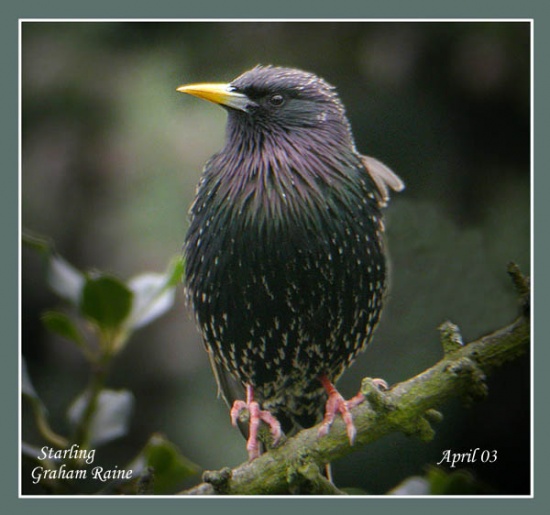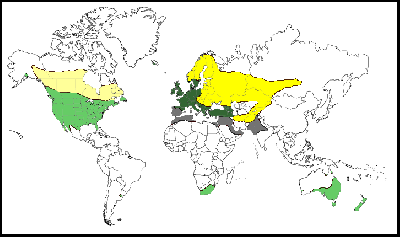(Pictures re-positioned. Reference updated) |
(update link) |
||
| Line 42: | Line 42: | ||
====Subspecies==== | ====Subspecies==== | ||
[[Image:Starling13.jpg|thumb|350px|right|Flight profile<br />Photo by {{user|targetman|targetman}}<br />Worlaby, [[Lincolnshire]], October 2007]] | [[Image:Starling13.jpg|thumb|350px|right|Flight profile<br />Photo by {{user|targetman|targetman}}<br />Worlaby, [[Lincolnshire]], October 2007]] | ||
| − | This is a [[ | + | This is a [[Dictionary_P-S#P|polytypic]] species, consisting of twelve subspecies<sup>[[#References|[1]]]</sup>: |
*''S. v. granti'': [[Azores]] | *''S. v. granti'': [[Azores]] | ||
*''S. v. vulgaris'': [[Canary Islands]] and [[Iceland]] to Ural Mountains, northern [[Ukraine]] and south-eastern [[Europe]] | *''S. v. vulgaris'': [[Canary Islands]] and [[Iceland]] to Ural Mountains, northern [[Ukraine]] and south-eastern [[Europe]] | ||
| Line 55: | Line 55: | ||
*''S. v. humii'': Western [[Himalayas]] (Kashmir to Garhwal) | *''S. v. humii'': Western [[Himalayas]] (Kashmir to Garhwal) | ||
*''S. v. minor'': Locally in western [[Pakistan]] (Sind) | *''S. v. minor'': Locally in western [[Pakistan]] (Sind) | ||
| + | |||
==Habitat== | ==Habitat== | ||
Varied. Can be found in any reasonably open environment from farmland to salt marsh. | Varied. Can be found in any reasonably open environment from farmland to salt marsh. | ||
Revision as of 20:08, 1 July 2014
Alternative name: European Starling
- Sturnus vulgaris
Identification
L. 20-22cm
Wide variation in plumage. Both sexes are similar, although the female is less glossy than the male.
Non-breeding
- Glossed black with a purple and green shine
- Tips of the body feathers have large white spots
- Dark bill
- Brown legs
With wear, the white spots are lost, while the bill and legs turn yellow.
Breeding
- Adults glossy-black, males without any spots, females with a few
- Yellow bill
Young birds are dull grey-brown with dark bill
Variation
Some of the eastern subspecies are completely spotless, and may show a violet gloss.
Similar species
Especially in south west Europe and north Africa, look at Spotless Starling which has a different structure in the feathers especially at the throat.
Distribution
| This starling is native to most of Eurasia, but in most of the Iberian Peninsula and north Africa only as winter guest. It has additionally been introduced to South Africa, North America, Australia and New Zealand. Common or abundant in most of its range | |
| Legend • S. vulgaris; original range, year-round |
Taxonomy
Subspecies
This is a polytypic species, consisting of twelve subspecies[1]:
- S. v. granti: Azores
- S. v. vulgaris: Canary Islands and Iceland to Ural Mountains, northern Ukraine and south-eastern Europe
- S. v. faroensis: Faeroes
- S. v. zetlandicus: Shetland Islands
- S. v. tauricus: Eastern and southern Ukraine, Crimea and Asia Minor
- S. v. purpurascens: Western Transcaucasia to Georgia and Armenia
- S. v. caucasicus: Volga Delta and northern Caucasus to Caspian Sea and southern Iran
- S. v. nobilior: Afghanistan, Transcaspia and Khorasan
- S. v. poltaratskyi: Eastern Ural Mountains to Lake Baikal, Kazakstan and western Mongolia
- S. v. porphyronotus: Southern Dzungaria and Tien Shan Mountains to Pamir Mountains and Samarkand
- S. v. humii: Western Himalayas (Kashmir to Garhwal)
- S. v. minor: Locally in western Pakistan (Sind)
Habitat
Varied. Can be found in any reasonably open environment from farmland to salt marsh.
Behaviour
Very gregarious out of the breeding season.
Movement
Starlings walk rather than hop. Their flight is quite strong and direct; they look triangular-winged and short-tailed in flight.
Breeding
Nests in thatches, nest boxes, tree holes. An untidy feather-lined nest is constructed from straw, grass or twigs. The clutch consists of 4-5 pale blue, glossy eggs with. They are incubated for around 2 weeks and flegde about 19-22 days later. There may be 2 broods in the season, which usually runs from April to July.
Diet
They mainly feed on insect larvae but are opportunist feeders and will visit bird tables. They also like autum berries.
Vocalisation
<flashmp3>Sturnus vulgaris (song).mp3</flashmp3>
Listen in an external program
References
- Clements, JF. 2010. The Clements Checklist of Birds of the World. 6th ed., with updates to December 2010. Ithaca: Cornell Univ. Press. ISBN 978-0801445019. Spreadsheet available at http://www.birds.cornell.edu/clementschecklist/Clements%206.5.xls/view
- Bird Watching
Recommended Citation
- BirdForum Opus contributors. (2024) Common Starling. In: BirdForum, the forum for wild birds and birding. Retrieved 23 April 2024 from https://www.birdforum.net/opus/Common_Starling
External Links
For videos of Starling Roosts









